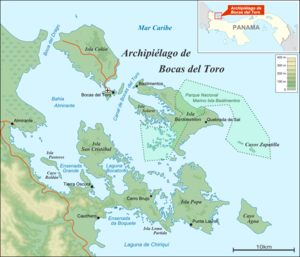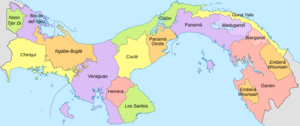Archaeology of Bocas del Toro facts for kids
The Archaeology of Bocas del Toro, Panama is like a detective story! It helps us learn about the people who lived in this part of Panama long before Europeans arrived. The first Europeans, Christopher Columbus and his son Fernando, visited in 1502. For many years after that, pirates and buccaneers often came to the area. But what about the people who lived there before them? Since the mid-1900s, archaeologists have been digging and studying. Their work helps us understand the ancient cultures and how societies grew in Bocas del Toro before Columbus's arrival.
Where is Bocas del Toro?
Bocas del Toro is one of Panama's ten provinces. It is located in the western part of the country. To the south, it borders the Chiriquí province. To the east, it touches Veraguas province, which includes the Ngöbe-Buglé Comarca. The Caribbean Sea is to the north, and Costa Rica is to the west.
Bocas del Toro also refers to a group of islands, called an archipelago. These islands stretch along the coast from the Seropta Peninsula to the Laguna de Chiriquí. Important islands include Isla Colón, Isla Solarte, Isla Bastimentos, Isla San Cristóbal, Isla Popa, and Cayo Agua.
The province is divided into three main areas: Chiriquí Grande, Changuinola, and Bocas del Toro. Major towns are Changuinola, Almirante, and Bocas del Toro (also called Bocas Town). Bocas Town is the capital and is on Isla Colon.
Early Discoveries
The first archaeological studies in Bocas del Toro happened in 1953. Mathew Stirling found "shell middens" along the coast. Shell middens are basically ancient trash piles, mostly made of shells from seafood people ate long ago. Not much was written about these early finds.
Later, a geographer named B.L. Gordon looked more closely at these shell middens. He started to understand the connection between the environment and the people who lived there. Gordon's digs mainly found mollusk shells. He also found some grinding stones (called metates) and a few pieces of pottery and stone tools.
From 1971 to 1972, Olga F. Linares did more detailed digs. She worked at the Cerro Brujo shell midden site. This site is on the Aguacate Peninsula, high on a ridge. It's about 3 kilometers from the ocean. Linares believed Cerro Brujo was a small village or "hamlet."
She found cultural items in two main trash areas. These items showed that people lived there for about 20 to 30 years. Scientists used radiocarbon dating to figure this out. This method uses carbon in old materials to tell their age. The dates for Cerro Brujo ranged from AD 960 to AD 985. In 1973, Linares explored the whole Aguacate Peninsula. She found three more shell midden sites similar to Cerro Brujo.
Newer Discoveries
The newest and most studied site in Bocas del Toro is Sitio Drago. It is on the northwest shore of Isla Colon. Thomas A. Wake from UCLA has been studying it since 2002. This site is on an old beach ridge, between the forest and the coral reef.
Sitio Drago has about 15 low mounds of layered trash (stratified midden) spread over 17 hectares. Digs there have found many interesting things. These include "prestige goods" (fancy items), many different types of tools, and more varied pottery than at Cerro Brujo.
Archaeologists found many kinds of pottery pieces and small clay figures. These show that the people at Sitio Drago traded with or were connected to the Pacific Chiriquí region. They also found various stone tools like celts (axe-like tools) and blades. Plus, there were many animal bones and mollusk shells.
Using radiocarbon dating on burnt wood and Raphia nuts, scientists learned that people lived at Sitio Drago from AD 900 to AD 1150. Because of the wide variety and large number of items found, Wake believes Sitio Drago was much larger and more complex than smaller farming villages like Cerro Brujo.
Ongoing Work
Sitio Drago is still being studied today by Thomas Wake and his team. This includes Tomas Mendizabal and Alexis Mojica. Their project is called the Proyecto Arqueológico Sitio Drago (PASD). Besides their own upcoming reports, students are also doing new research. They are working both at Sitio Drago and in other parts of Isla Colón.



